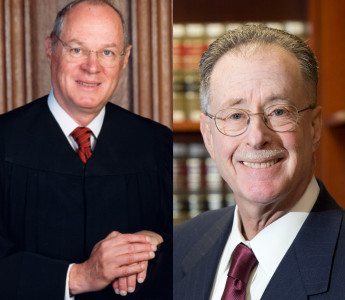Buck v. Davis, 580 U.S. ___ (2017) (Roberts, J.).
Response by Robin M. Maher
Geo. Wash. L. Rev. On the Docket (Oct. Term 2016)
Slip Opinion | New York Times | SCOTUSblog
Fulfilling the Promise of Justice
The State of Texas spent twenty years trying to execute Duane Buck after securing a death sentence that was undisputedly tainted by racial bias and facilitated by Buck’s own incompetent defense counsel. When a recalcitrant prosecution reneged on a promise to provide him with the fair sentencing hearing he deserved, Buck’s case became a study about all that is wrong with the death penalty. On Wednesday, more than five years after a sharply divided Supreme Court first turned him away, Buck finally received justice. In a six to two decision, the United States Supreme Court reversed and remanded the decision below, holding that Buck’s death sentence was the unjust result of racial discrimination.
Buck’s story began in 1997, when he was convicted of capital murder for killing his former girlfriend and another man. There was little doubt about Buck’s guilt—he was arrested at the scene and made self-incriminating statements. His sentence was a different matter, however. The critical question was whether Buck posed a continuing danger to society. In Texas, “future dangerousness”1 is one of the special circumstances that a jury must find to exist—unanimously and beyond a reasonable doubt—before a defendant may be sentenced to death.2 The jury spent two days considering the evidence and deliberating between life and death for Buck.
Unfortunately, Buck shared the misfortune of many other Texas capital defendants when he was appointed incompetent defense counsel.3 His lawyers retained Dr. Walter Quijano as an expert to opine about Buck’s future dangerousness. The first sign of trouble was Quijano’s report, which indicated that he viewed Buck’s race as a risk factor. Despite knowing this, however, Buck’s lawyers called Quijano to testify as an expert witness in the penalty phase. On cross-examination, the prosecutor seized upon the opportunity to specifically hammer home the point in Quijano’s report that Buck’s race increased the probability that he would pose a future danger to society:
- Q: You have determined that… the race factor, black, increases the future dangerousness for various complicated reasons; is that correct?
- A: Yes.
Using race to stoke fear and hatred has a long and sordid history in the United States, and as recent events remind us, it is not even in the past.4 Racial discrimination in the criminal justice system, abundantly and unapologetically on display at the time the Supreme Court decided Furman v. Georgia,5 was one important reason the death penalty was struck down in 1972.6 Later cases specifically identified the dangerous effects that race-based fears of violence could have on jurors in death penalty cases.7
Defense lawyers must be vigilant and zealous to ensure that racial discrimination does not affect the fairness of criminal proceedings. But Buck’s court-appointed lawyers were neither. Their decision to call Quijano not only provided “expert” support for any race-based fears held by members of the jury; his report, referencing “statistical factors,” also created the false and damaging impression that those discriminatory beliefs were legitimate. Influenced by Quijano’s testimony and report, the jury found Buck to be a future danger and sentenced him to death.
Now the subject of appeal, Buck was once again appointed counsel who was simply not up to the task. His lawyer filed just four non-cognizable and frivolous claims in his state habeas petition—and bewilderingly, did not at all challenge trial counsel’s introduction of the race-based expert testimony at sentencing. The Texas Court of Criminal Appeals quickly dismissed his appeal.8
Meanwhile, another death-sentenced prisoner whose trial had been similarly infected by Quijano’s inflammatory, race-based testimony had better luck with competent counsel. In 2000, after that prisoner’s successful legal challenge,9 Texas made an unprecedented concession: “[T]he use of race in [the defendant’s] sentencing seriously undermined the fairness, integrity, or public reputation of the judicial process,” said then-Attorney General John Cornyn.10 As a consequence, he said that Texas would not oppose new sentencing hearings for six other cases in which Quijano had testified.
But Buck’s elation was short lived: Texas soon announced that it would make a single “exception” to its promise and would oppose relief in Buck’s case. The reason given: Buck’s defense counsel, not the prosecution, had called Quijano. Texas maintained that for this reason, Buck was the only one not entitled to sentencing relief.11
Buck filed a federal habeas petition in 2004, arguing that his trial counsel had been ineffective by introducing the race-based expert testimony, and that as a consequence, his death sentence was a miscarriage of justice. Texas opposed Buck’s petition, essentially arguing that it should once again benefit from the incompetence of Buck’s state-appointed counsel, this time because the ineffectiveness claim had not been properly pled by his state habeas counsel. The federal district court agreed and dismissed the claim.12
In the years that followed, there were more appeals, attempts to negotiate a settlement with the state, and a public campaign13 seeking a new sentencing hearing for Buck, but none was successful. By 2011, Buck had an execution date and had reached the United States Supreme Court. Once again, however, Buck faced disappointment. Although the Court denied certiorari, the unusual statements issued by members of the Court made clear the controversial nature of the case. Justice Sotomayor, joined by Justice Kagan, issued a strongly worded dissent:
Today the Court denies review of a death sentence marred by racial overtones and a record compromised by misleading remarks and omissions made by the State of Texas in the federal habeas proceedings below. Because our criminal justice system should not tolerate either circumstance—especially in a capital case—I dissent and vote to grant the petition.14
Justice Alito issued his own statement, and was joined by Justices Scalia and Breyer. Although acknowledging that the expert’s testimony was “bizarre and objectionable,” Justice Alito agreed with Texas courts that “ . . . the responsibility for eliciting the offensive testimony lay squarely with the defense.”15 In other words, a death-sentenced defendant would once again suffer the consequences of being appointed incompetent counsel whom he neither selected, directed, or controlled, but whose decisions and actions were imputed to him, even at the cost of his own life.16
Over the next few years, Buck miraculously avoided execution while his new—and for the first time, competent—lawyers fought their way back into Texas courts with claims made viable by recent court decisions.17 In 2014, Buck’s lawyers laid out eleven “extraordinary circumstances” in his case, arguing that they required the federal district court to set aside the final judgment of his first habeas appeal and reopen the case for merits review of the ineffectiveness of counsel claim pursuant to Federal Rules of Civil Procedure Rule 60(b)(6).18
The district court, however, found nothing extraordinary about Buck’s case, and nothing troubling about the State’s revocation of its promise of a new sentencing hearing. Moreover, the court held, Buck’s claim of ineffectiveness by trial counsel failed because the mention of race was merely “de minimis.”19
Buck then turned to the Court of Appeals for the Fifth Circuit. Under the unique “gatekeeping” procedures governing habeas corpus, Buck had no right to appeal the adverse ruling by the federal district court. He had to first obtain a Certificate of Appealability (“COA”), which is statutorily premised on a “substantial showing of a violation of constitutional law.”20 Each court of appeals employs its own test for deciding whether the standard is met and the Fifth Circuit, instead of making only a threshold inquiry, analyzed the merits of each of the eleven reasons Buck identified, determined that the circumstances were “not extraordinary at all,” and denied a COA. It further held that the performance of his trial counsel, while negligent, did not prejudice Buck, and therefore did not constitute ineffectiveness.21
The decision left Buck with one last option: another appeal to the United States Supreme Court. In June 2016, the Court agreed to hear Buck’s case. The question presented:
Whether the Fifth Circuit imposed an improper and unduly burdensome Certificate of Appealability (COA) standard that contravenes this Court’s precedent and deepens two circuit splits when it denied petitioner a COA on his motion to reopen the judgment and obtain merits review of his claim that his trial counsel was constitutionally ineffective for knowingly presenting an “expert” who testified that petitioner was more likely to be dangerous in the future because he is Black, where future dangerousness was both a prerequisite for a death sentence and the central issue at sentencing.
Although technical, the procedural question was of serious interest to death penalty practitioners and more importantly, had real significance to death-sentenced prisoners. Research conducted by Buck’s lawyers and submitted with their briefs identified a huge disparity between the COAs granted by the Fifth Circuit compared with those granted by other circuits.22 For example, the data showed that the Fifth Circuit denied 60% of all COA requests in death penalty cases, while the Eleventh Circuit denied only 6% of COA requests in death penalty cases, and the Fourth Circuit denied none.23 In human terms, this means that 60% of death-sentenced prisoners who applied for a COA in the Fifth Circuit were procedurally denied an important opportunity—perhaps their last opportunity—to make potentially life-saving legal arguments.24
The Court heard oral arguments on October 5, 2016. Christina Swarns, the NAACP Legal Defense Fund’s Litigation Director, argued for Buck. Early on, Chief Justice Roberts, Justice Kagan, and Justice Sotomayor seemed ready to rule for Buck when they questioned Swarns about the remedy Buck was seeking: was it just a COA, or was it a relief on the merits? Justice Alito expressed concern about the possible effect a decision could have in other cases, but had no difficulty with the underlying facts in the case, stating at one point, “What occurred at the penalty phase of this trial is indefensible.”25
Scott Keller, the Solicitor General of Texas, faced tough questions. Chief Justice Roberts asked him why it mattered that Quijano was initially called by the defense, if everyone agreed the raced-based evidence should not have come in. Keller maintained that the evidence was “more prejudicial” when introduced by the prosecution. Justice Kagan countered that when the defendant’s own lawyer introduces the evidence, the result is “wildly more prejudicial” because the jury notices that “even the defendant’s own lawyer thinks that this is true.” Keller was also asked a number of questions about how the Fifth Circuit decided whether to grant a COA, suggesting a broader concern that went beyond the facts of the Buck case.26
On February 22, 2017, the Court announced its decision. Chief Justice Roberts wrote for the six-person majority, with Justices Thomas and Alito dissenting.
It was a bad day for Texas. The Court first found that Buck should have received a COA, holding that the Fifth Circuit had erred by conducting a merits analysis instead of making the proper threshold COA determination.27 The Court then turned to the federal district court’s decision, finding that it had abused its discretion when it denied Buck’s Rule 60(b)(6) motion.28 The district court’s error was “exacerbated,” the Court explained, “because it concerned race.” Citing its previous decisions, the Court reaffirmed that “discrimination on the basis on race, odious in all aspects, is especially pernicious in the administration of justice,” harming not only the defendant, but the law as an institution, the community, and the democratic ideals reflected in the process of the courts.29 “Our law,” Chief Justice Roberts wrote, “punishes people for what they do, not who they are.”30
In dissent, Justice Thomas countered that there cannot be injury to public confidence when defense counsel is at fault.31 But this makes no sense. When the infection of racial prejudice is permitted to cause a man’s death, the injustice is clear, and few if any members of the public would set aside their concerns about the legitimacy, accuracy, and fairness of the judicial system simply because it was the defendant’s lawyer—appointed by the same government that seeks his death—whose neglect or bad decision caused the discrimination to occur.
On the substantive question of trial counsel’s ineffectiveness, Chief Justice Roberts wrote that that it was “proper” given the circumstances to evaluate the underlying merits of the claim—a decision the dissent disparaged as “astonishing.”32 The Court first found that trial counsel had been clearly deficient in presenting testimony that “[n]o competent defense attorney would introduce . . . about his own client.”33 In finding that Buck was also prejudiced by trial counsel’s performance, the Court explained that determining Buck’s future dangerousness required the jury to make a “predictive judgment” which entailed “a degree of speculation.” The nature of the inquiry, combined with the “potent” race-based expert testimony appealing to a “powerful racial stereotype,” created a “perfect storm” of circumstances that prejudiced Buck:
Dr. Quijano’s testimony coincided precisely with a particularly noxious strain of racial prejudice, which itself coincided precisely with the central question at sentencing. The effect of this unusual confluence of factors was to provide support for making a decision on life or death on the basis of race.34
The effect was far from “de minimis”:
When a jury hears expert testimony that expressly makes a defendant’s race directly pertinent on the question of life or death, the impact of that evidence cannot be measured simply by how much air time it received at trial or how many pages it occupies in the record. Some toxins can be deadly in small doses.35
Finally, the Court rejected the State’s longstanding argument that the testimony could not be prejudicial because it was Buck’s own counsel who called the expert. “When a defendant’s own lawyer puts in the offending evidence, it is in the nature of an admission against interest, more likely to be taken at face value.”36 The Court was also unconvinced by the State’s attempt to justify its exclusion of Buck from the relief it granted others, concluding that considering race as a factor in the penalty phase was inappropriate no matter which party called the expert.37
The Court did leave one question unanswered, however. For the first time, Texas had argued in the Supreme Court that Teague v. Lane38 prevented Buck from benefiting from the decisions in Martinez v. Ryan39 and Trevino v. Thaler40 because they were “new rules” without retroactive effect. Although Buck disputed Teague’s effect, he also argued that the State had waived any Teague argument because it had not made it earlier. The Court agreed that the Teague argument was waived and therefore that Martinez and Trevino both apply to Buck’s claim—but “reach[ed] no broader determination concerning the application of Martinez and Trevino.”41
In dissent, Justice Thomas, joined by Justice Alito, was firm in his (perhaps hopeful) belief that the Buck decision will have little significance. Using the majority’s “perfect storm” analogy as a limiting principle, Justice Thomas argued first that the circumstances of Buck’s case “will rarely, if ever, recur.”42 Second, he asserted that although the majority’s decision “bulldozes procedural obstacles and misapplies settled law,” it does not change longstanding legal doctrines governing collateral review, ineffective assistance of counsel claims, and Rule 60(b)(6) motions.43 The only point upon which the dissent and the majority agreed is that the facts in Buck’s case were “highly unusual.” In the dissent’s view, however, the Court’s “highly factbound” reasoning also means the decision will have “little effect on the broader law.”42 This, of course, remains to be seen.
In closing, Justice Thomas cautioned the lower courts not to “reflexively” accord relief to Buck, despite the majority’s determination that his trial counsel was constitutionally ineffective.43 But it will be impossible to justify any other result. Buck’s case is emblematic of much that is wrong with the death penalty: racial discrimination, incompetent defense counsel, prosecutorial misconduct, the exaltation of procedure over fairness, and the priority placed on achieving “finality” instead of justice. He should receive a fair sentencing hearing, one that is not poisoned by racial bias, or a commutation of his death sentence to a life sentence. After twenty years, our legal system must now correct an injustice that is long overdue.
Robin M. Maher is a capital defender and a Professional Lecturer in Law at The George Washington University Law School. Previously, she was the Director of the American Bar Association Death Penalty Representation Project. In addition to direct representation, Ms. Maher’s work has included legal reform efforts with state and national legislators; training of judges and defense lawyers on the fundamentals of effective capital defense; systemic litigation in jurisdictions that fail to provide necessary defense services; and recruitment of volunteer lawyers from civil law firms to represent death-sentenced persons who are without counsel. She is a frequent trainer of lawyers and judges in the United States and internationally. Ms. Maher led the effort that resulted in the American Bar Association Guidelines for the Performance of Defense Counsel in Death Penalty Cases, now the national standard of care for the capital defense effort. The opinions in this article are strictly her own.
- There are strong reasons to question the accuracy of predictions of violence made by prosecution experts in capital murder trials. See generally Texas Defender Service, Deadly Speculation: Misleading Texas Capital Juries with False Predictions of Future Dangerousness (2004), http://texasdefender.org/wp-content/uploads/TDS_Deadly-Speculation.pdf.
- The Supreme Court has approved of a jury’s consideration of future dangerousness during the penalty phase of a capital trial, noting that “any sentencing authority must predict a convicted person’s probable future conduct when it engages in the process of determining what punishment to impose.” Jurek v. Texas, 428 U.S. 262, 275 (1976); see also California v. Ramos, 463 U.S. 992, 1003, 1003 n.17 (1983) (explaining that it is proper for a sentencing jury in a capital case to consider “the defendant’s potential for reform and whether his probable future behavior counsels against the desirability of his release into society”).
- One of Buck’s lawyers was the notorious subject of a New York Times article: Adam Liptak, A Lawyer Known Best for Losing Capital Cases, N.Y. Times: Sidebar (May 17, 2010), http://www.nytimes.com/2010/05/18/us/18bar.html.
- See, e.g., Caitlin Dickerson, Reports of Bias-Based Attacks Tick Upward After Election, N.Y. Times (Nov. 11, 2016), https://www.nytimes.com/2016/11/12/us/reports-of-bias-based-attacks-tick-upward-after-election.html.
- 408 U.S. 238 (1972).
- See, e.g., id. at 364–65 (Marshall, J., concurring) (“Regarding discrimination, it has been said that ‘[i]t is usually the poor, the illiterate, the underprivileged, the member of the minority group – the man who, because he is without means, and is defended by a court-appointed attorney – who becomes society’s sacrificial lamb . . . .’ Indeed, a look at the bare statistics regarding executions is enough to betray much of the discrimination. A total of 3,859 persons have been executed since 1930, of whom 1,751 were white and 2,066 were Negro. Of the executions, 3,334 were for murder; 1,664 of the executed murderers were white and 1,630 were Negro; 455 persons, including 48 whites and 405 Negroes, were executed for rape. It is immediately apparent that Negroes were executed far more often than whites in proportion to their percentage of the population. Studies indicate that while the higher rate of execution among Negroes is partially due to a higher rate of crime, there is evidence of racial discrimination. Racial or other discriminations should not be surprising. In McGautha v. California . . . this Court held ‘that committing to the untrammeled discretion of the jury the power to pronounce life or death in capital cases is [not] offensive to anything in the Constitution.’ This was an open invitation to discrimination.”).
- In Turner v. Murray, the Court wrote that a juror who “believes that blacks are violence prone . . . might well be influenced by that belief in deciding whether petitioner’s crime involved the aggravating factors” required for a death sentence; “[s]uch a juror might also be less favorably inclined toward petitioner’s” mitigating evidence. 476 U.S. 28, 35 (1986) (plurality opinion); see Petitioner’s Reply Brief at 7, Buck v. Davis, No. 15-8049 (U.S. Feb. 22, 2017).
- Ex Parte Buck, No. 699684-A (Dist. Ct. Harris Cty. Tex. July 11, 2003). Two years after Texas confessed error, Buck’s state habeas counsel filed an untimely amendment in state court alleging, for the first time, that trial counsel was ineffective for introducing Quijano’s testimony. The application was dismissed by the state court of criminal appeals as an abuse of the writ without considering the merits of the claim. Ex Parte Buck, Nos. 57,004-01, 57,004-02 (Tex. Crim. App. Oct. 15, 2003) (per curiam).
- Saldano v. Texas, 530 U.S. 1212 (2000).
- Press Release, Texas Office of the Attorney General, Statement from Attorney General John Cornyn Regarding Death Penalty Cases (June 9, 2000), http://texasattorneygeneral.gov/newspubs/newsarchive/2000/20000609death.htm.
- This was, in fact, incorrect. In two of the other five cases that received new sentencing hearings the defense had also called Quijano as an expert. See Buck v. Thaler, 565 U.S. 1022 (2011).
- Buck v. Dretke, No. H-04-3965, 2006 WL 8411481 (S.D. Tex. July 24, 2006).
- Buck’s stepsister, who survived being shot by Buck in the same crime, and one of the prosecutors from Buck’s trial were among those who advocated for a new sentencing hearing. More than 100 Civil Rights Leaders, Elected Officials, Clergy, Former Prosecutors and Judges, Past ABA Presidents, and a Former TX Governor Call for New, Fair Sentencing for Duane Buck, NAACP Legal Defense Fund (Mar. 20, 2013), http://www.naacpldf.org/news/more-100-civil-rights-leaders-elected-officials-clergy-former-prosecutors-and-judges-current.
- Buck v. Thaler, 565 U.S. 1022 (2011) (Sotomayor, J., dissenting from denial of cert).
- Id. (Alito, J.).
- See Hutchinson v. Florida, 677 F.3d 1097, 1104–09 (11th Cir. 2012) (Barkett, J., concurring in the result only) (detailing why traditional agency principles should not apply in death penalty cases); Adam Liptak, Agency and Equity: Why Do We Blame Clients For Their Lawyers’ Mistakes?, 110 Mich. L. Rev. 6 (2012).
- Prior to 2012, an attorney’s negligence in a post-conviction proceeding could not excuse a procedural default. See Coleman v. Thompson, 501 U.S 722 (1991). But decisions in Martinez v. Ryan, 566 U.S. 1 (2012), and Trevino v. Thaler, 133 S. Ct. 1911 (2014), modified that rule and allowed a federal court to excuse the procedural default of certain claims in state court based on the ineffective assistance of state post-conviction counsel. Buck’s state habeas counsel procedurally defaulted the claim that trial counsel was ineffective for introducing Quijano’s testimony; the decisions in Martinez and Trevino meant that a federal court might have reason to excuse that default and consider the merits of the ineffectiveness claim.
- Fed. R. Civ. P. 60 (“Relief From a Judgment or Order:(b) Grounds for Relief from a Final Judgment, Order, or Proceeding.On motion and just terms, the court may relieve a party or its legal representative from a final judgment, order, or proceeding for the following reasons: . . . (6) any other reason that justifies relief.”). Relief is available under the catchall category in (b)(6) only in “extraordinary circumstances” that “rarely occur in the habeas context.” Gonzales v. Crosby, 545 U.S. 524, 535 (2005).
- Buck v. Stephens, No. H–04–3965, 2014 WL 11310152, at *4–*5 (S.D. Tex. Aug. 29, 2014).
- Texas requires a COA to appeal the denial of a Rule 60(b) motion. 28 U.S.C. § 2253(c)(2) (2012) states that a COA should issue when (1) jurists of reason would find debatable “whether the petition states a valid claim of the denial of a constitutional right” and (2) those jurists “would find it debatable whether the district court was correct in its procedural ruling.” Slack v. McDaniel, 529 U.S. 473, 484 (2000). When evaluating a COA application, “the court of appeals should limit its examination to a threshold inquiry into the underlying merit of his claims.” Miller-el v. Cockrell, 537 U.S. 322, 326 (2003). A petitioner is not required to demonstrate that he is entitled to relief; in fact, “[i]t is consistent with § 2253 that a COA will issue in some instances where there is no certainty of ultimate relief.” Id. at 337.
- Buck v. Stephens, 623 F. App’x 668, 669, 673–74 (5th Cir. 2015); see also Strickland v. Washington, 466 U.S. 668, 687 (1984) (“A convicted defendant’s claim that counsel’s assistance was so defective as to require reversal of a conviction or death sentence has two components. First, the defendant must show that counsel’s performance was deficient . . . . Second, the defendant must show that the deficient performance prejudiced the defense.”).
- See Petitioner’s Brief at 1a–29a, Buck v. Davis, No. 15-8049 (U.S. Feb. 22, 2017); Linda Greenhouse, Under Trump, the Federal Courts Will Be Up for Grabs, N.Y. Times (Dec. 8, 2016), https://www.nytimes.com/2016/12/08/opinion/under-trump-the-federal-courts-will-be-up-for-grabs.html (discussing the circuit statistics presented in Buck’s Supreme Court brief).
- See Petitioner’s Brief at 3a, Buck v. Davis, No. 15-8049 (U.S. Feb. 22, 2017).
- In the Fifth Circuit, at least twenty-eight innocent men and women were sentenced to death in the modern death penalty era and later exonerated with evidence of their innocence, thirteen in the State of Texas alone. The Innocence List, Death Penalty Info. Ctr., http://www.deathpenaltyinfo.org/innocence-list-those-freed-death-row (last updated Jan. 19, 2017).
- Transcript of Oral Argument at 10, Buck v. Davis, No. 15-8049 (U.S. Feb. 22, 2017).
- Id. at 35–40.
- Buck v. Davis, No. 15-8049, slip op. at 13, (U.S. Feb. 22, 2017).
- Id. at 21.
- Id. at 22 (quoting Rose v. Mitchell, 443 U.S. 545, 555 (1979)).
- Id. at 21.
- Id. at 8 (Thomas, J., dissenting).
- Id. at 3.
- Id. at 17 (majority opinion).
- Id. at 19.
- Id. at 19–20.
- Id. at 20.
- Id.
- 489 U.S. 288 (1989).
- 566 U.S. 1 (2012).
- 133 S. Ct. 1911 (2014).
- Buck, slip op. at 26.
- Id. at 10 (Thomas, J., dissenting).
- Id. at 1, 11.
- Id. at 9.
- Id. at 12.
Recommended Citation:
Robin Maher, Response, Buck v. Davis: Fulfilling the Promise of Justice, Geo. Wash. L. Rev. On the Docket (Feb. 26, 2017), http://www.gwlr.org/buckvdavis/.





